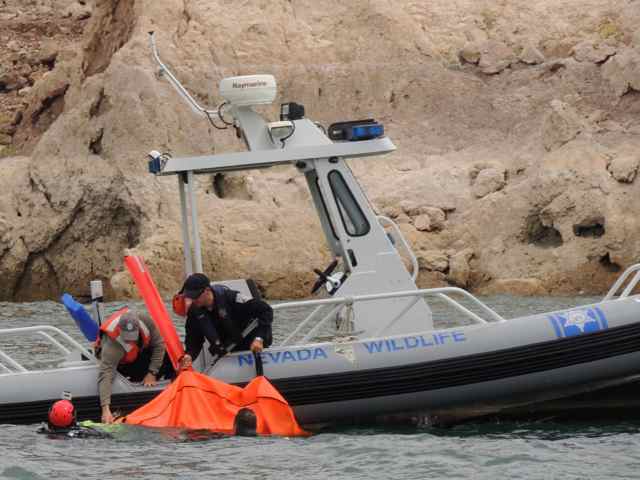Long Range Fish Report
From Sportfishing
From Sportfishing
Fish Report for 6-26-2013
American Coot Selected for 2014 Duck Stamp Art Contest
6-26-2013
Aaron Meier
The Nevada Waterfowl Association (NWA) has selected the American Coot for this year's Nevada Duck Stamp Art Contest.
The 2014 Nevada Duck Stamp Art Contest is sanctioned by the Nevada Board of Wildlife Commissioners, with the winning artwork to be featured on the 2014-2015 state stamp.
All interested artists are encouraged to enter the contest, whether residing in Nevada or elsewhere. Entries must be an original creation, in any drawing medium and must be received by the Nevada Department of Wildlife (NDOW) no later than October 18, 2013. Contest rules are available on the NDOW website at ndow.org, or by calling (775) 688-1998 for more information.
Coots are medium-sized, chicken-like birds that are members of the Rallidae (rail) family. Although the American Coot (Fulica americana) is commonly mistaken for a duck, they actually belong to their own distinct order. Where a duck has webbed feet, a coot has broad lobes on their toes. American Coots typically live in wetlands and open water bodies in North America in groups called covers or rafts. The bird is a highly social species with flocks sometimes numbering in the thousands.
The American Coot is typically 13-17 inches in length. Adults have a short, thick, white bill and white frontal shield, which usually has a reddish-brown spot near the top of the bill between the eyes. Males and females look alike, but females are smaller.
Entries will be judged by seven individuals, including two members of the NBWC and five others as appointed by the Nevada Waterfowl Association. The names of the top ten finalists will be announced by NDOW on November 18, 2013.
In the state of Nevada, any person 12-64 years old who hunts any migratory bird except mourning or white-winged dove, snipe, coot or moorhen (gallinule) is required to purchase a state duck stamp. Money from the sale of Nevada Duck Stamps is used for projects approved by the Commission for the protection and propagation of migratory game birds, and for the acquisition, development and preservation of wetlands in Nevada.
The 2014 Nevada Duck Stamp Art Contest is sanctioned by the Nevada Board of Wildlife Commissioners, with the winning artwork to be featured on the 2014-2015 state stamp.
All interested artists are encouraged to enter the contest, whether residing in Nevada or elsewhere. Entries must be an original creation, in any drawing medium and must be received by the Nevada Department of Wildlife (NDOW) no later than October 18, 2013. Contest rules are available on the NDOW website at ndow.org, or by calling (775) 688-1998 for more information.
Coots are medium-sized, chicken-like birds that are members of the Rallidae (rail) family. Although the American Coot (Fulica americana) is commonly mistaken for a duck, they actually belong to their own distinct order. Where a duck has webbed feet, a coot has broad lobes on their toes. American Coots typically live in wetlands and open water bodies in North America in groups called covers or rafts. The bird is a highly social species with flocks sometimes numbering in the thousands.
The American Coot is typically 13-17 inches in length. Adults have a short, thick, white bill and white frontal shield, which usually has a reddish-brown spot near the top of the bill between the eyes. Males and females look alike, but females are smaller.
Entries will be judged by seven individuals, including two members of the NBWC and five others as appointed by the Nevada Waterfowl Association. The names of the top ten finalists will be announced by NDOW on November 18, 2013.
In the state of Nevada, any person 12-64 years old who hunts any migratory bird except mourning or white-winged dove, snipe, coot or moorhen (gallinule) is required to purchase a state duck stamp. Money from the sale of Nevada Duck Stamps is used for projects approved by the Commission for the protection and propagation of migratory game birds, and for the acquisition, development and preservation of wetlands in Nevada.
< Previous Report Next Report >
More Reports
Nevada Department of Wildlife Reports
for Wednesday, June 26th, 2013
Lake Mead: Lake Mead Stripers are moving tho the shallows in the evening to feed
Lake Mohave: Anglers fishing near Willow Beach between mile markers 49 and 52 at Lake Mohave have good fishing.
Las Vegas Urban Ponds: Las Vegas Ponds are getting action from some scrappy BLuegill
Kirch Wildlife Management Area: They are getting more weeds at the Kirch Wildlife Management Area, making the fishing tougher
Eagle Valley Reservoir: Rainbows & Brown Trout are biting at Eagle Valley Reservoir
Echo Canyon Reservoir: Bass fishing at Echo Canyon Reservoir has been phenomenal
• Boating Fatality Shows Dangers of High Winds, Swimming From Boats

6-25-2013
Agency Participates in Nationwide Effort Following Local, High Profile Incidents Game wardens with the Nevada Department of Wildlife (NDOW)...... Read More

LongRangeSportfishing.net © 2025. All Rights Reserved.
Website Hosting and Design provided by TECK.net
Website Hosting and Design provided by TECK.net